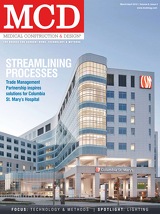Medical Construction & Design (MCD) is the industry's leading source for news and information and reaches all disciplines involved in the healthcare construction and design process. To view more past issues go to: http://mcdmag.epubxpress.com
Page 45 of 70
TECHNOLOGY & METHODS
jacked underground, minimizing disruption of this key intersection and saving $1.25 million. As an additional benefi t to the owner, this utility corridor, or "utilidor," provides the facilities team with direct underground access between the hospital and the central utility plant. The design required signifi cant support steel to hold
the curtainwall, brick façade and metal panel system to the building. Using the model, the team prefabricated large sections of the support system and set them in panelized units on the side of the building, increasing productivity and jobsite safety. Throughout the project, the IPD team used BIM to
work with the city of Puyallup on the permitting process. The city used the models to visualize the construction of a roadway roundabout on the sloped hillside, including sizing for detention basins. The project team also used BIM in working with telephone and cable services to model the installation in the hillside prior to fi nal grading.
PROVIDING GOOD SAMARITAN WITH AN OPERATION & MAINTENANCE TOOL
BIM is mostly regarded as a tool to enhance design, engineering and construction, and that's where the story ends — but not in this case. The IPD team, including leaders of Good Samaritan Hospital, understands the potential for BIM to enhance O&M; going forward as a "6-D" computer-aided facility management system. As the project drew to completion, the IPD team
fi nished loading as-built information into the BIM, including detailed data on the MEP systems. Training was also provided for the Good Samaritan facilities team in use of the CAFM system. The IPD team also linked training videos to the BIM model so staff can refresh their knowledge of service and maintenance in the fi eld as they are working on a piece of equipment. Technology is only part of the solution to a complex
problem. Collaboration among a multidisciplinary team of professionals is the real key to a successful outcome. For the project team at MultiCare Good Samaritan Hospital, Integrated Project Delivery and BIM were successful in delivering a healthcare facility to meet the needs of patients, families and the clinical care team well into the future.
Mark Howell is senior vice president of Skanska USA Building in Seattle. Howell has 28 years of construction project- management experience, with a focus on healthcare. He is a member of the American Society of Healthcare Engineers, Washington State Society of Healthcare Engineers, Architects in Healthcare Practice and the Lean Construction Institute.
MULTICARE GOOD SAMARITAN HOSPITAL PROJECT TEAM
Owner: C.B.Richard Ellis, The Good Sam Design Collaborative
Architects: Joint venture of Clark/Kjos Architects and Giffi n Bolte Jurgens Construction Manager: Skanska USA Building Civil/Structural Engineer: ABKJ MEP: CDi Engineers
Electrical/Lighting Engineer: Sparling
www.mcdmag.com
March/April 2012 | Medical Construction & Design 41
